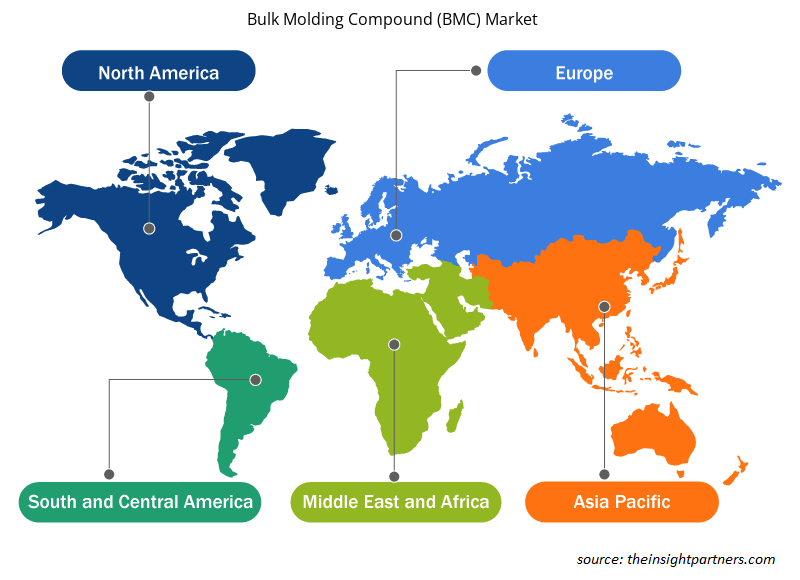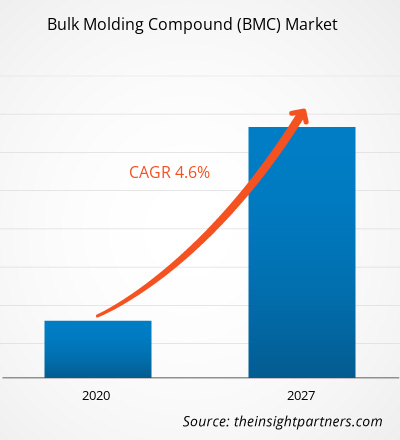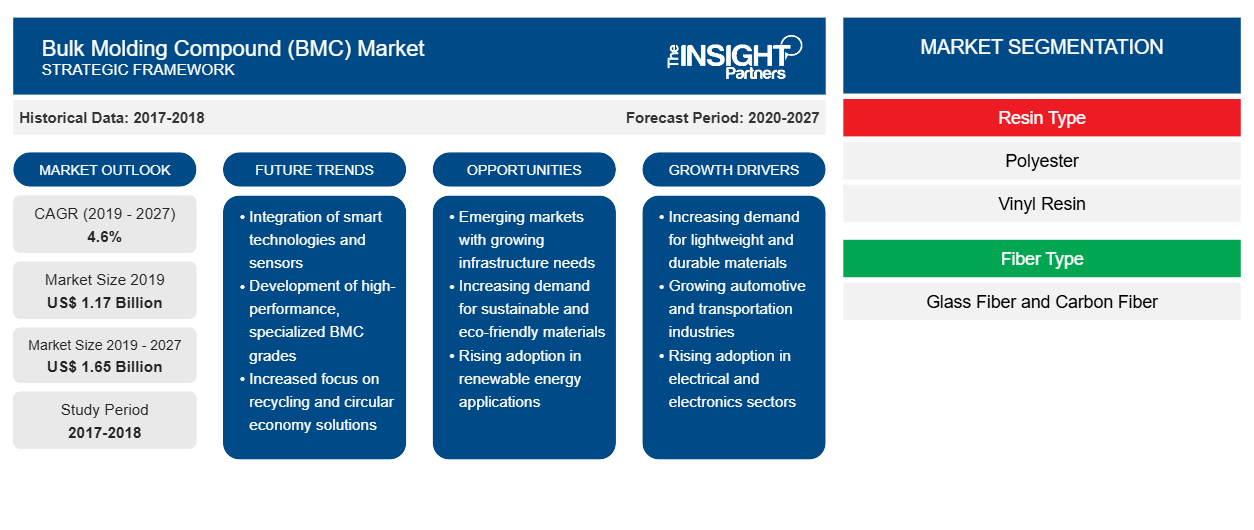Il mercato del composto per stampaggio sfuso (BMC) è stato valutato a 1.167,64 milioni di dollari nel 2019 e si prevede che raggiungerà 1.650,58 milioni di dollari entro il 2027; si prevede che crescerà a un CAGR del 4,6% durante il periodo di previsione 2020-2027
Il composto per stampaggio in massa (BMC) è un materiale polimerico termoindurente rinforzato con fibra di vetro pronto per lo stampaggio, utilizzato nello stampaggio a compressione, insieme allo stampaggio a iniezione e allo stampaggio a trasferimento. Il BMC viene prodotto mescolando resina poliestere termoindurente insatura, resina vinilestere o resina epossidica insieme a fili di fibre di vetro tritate, stirene, un iniziatore e un riempitivo in un miscelatore. La miscelazione per la preparazione del BMC viene effettuata a temperatura ambiente e conservata a basse temperature per rallentare la polimerizzazione prima dello stampaggio.
La domanda di materiali leggeri con elevata resistenza alla trazione è in aumento in diversi settori, come quello automobilistico, aerospaziale e delle costruzioni. L'uso di materiali leggeri ha un impatto diretto sulla dinamica complessiva e sulla struttura dei componenti in cui vengono utilizzati. Il BMC è uno di questi materiali compositi, prodotto con l'ausilio di matrici polimeriche termoindurenti. Il materiale utilizzato nei compositi per stampaggio in massa possiede diverse proprietà, come buona capacità di stampaggio, elevata stabilità dimensionale, eccellenti proprietà meccaniche ed elettriche e resistenza a sostanze chimiche e corrosione. Inoltre, è leggero e piuttosto economico, il che lo rende un componente ideale da utilizzare in diverse applicazioni. La domanda di BMC è notevolmente aumentata nei settori automobilistico e aerospaziale grazie ai crescenti progressi e innovazioni in questi settori.
Peso e resistenza sono due fattori importanti che determinano la resistenza di un veicolo. Una leggera riduzione del peso migliora le prestazioni di un veicolo. I compositi sono diventati un materiale strategico fondamentale per gli OEM automobilistici e i componenti aerospaziali. Pertanto, l'uso crescente di BMC nei settori automobilistico e aerospaziale offre un ampio margine per la crescita del mercato dei composti per stampaggio in massa (BMC) in tutto il mondo. Inoltre, i compositi BMC stanno guadagnando terreno in diverse applicazioni elettriche ed elettroniche grazie alle loro proprietà come la resistenza al calore e alla corrosione, la stabilità dimensionale e altre. Pertanto, con la crescente domanda di materiali leggeri, ad alta resistenza e ignifughi in vari settori di utilizzo finale, si prevede che il mercato del BMC aumenterà.
Si prevede che il Nord America deterrà la quota maggiore del mercato globale dei composti per stampaggio in massa (BMC) durante il periodo di previsione. Ciò è dovuto principalmente al fatto che diverse aziende nazionali e internazionali hanno una solida posizione in Nord America. Queste aziende stanno costantemente migliorando i processi aziendali complessivi per soddisfare le richieste dei clienti nel miglior modo possibile. La regione supporta ampiamente la crescita del mercato dei composti per stampaggio in massa (BMC) attraverso efficaci politiche di produzione e commerciali. Il BMC è un composito polimerico rinforzato con fibre noto per la sua maggiore resistenza meccanica, elevata stabilità dimensionale, eccellenti proprietà elettriche e molte altre proprietà relative. Grazie a tali proprietà, il BMC è utilizzato in diversi settori di utilizzo finale come l'automotive e i trasporti, l'aerospaziale e l'edilizia e le costruzioni. Pertanto, si prevede che la crescita di questi settori nella regione guiderà la crescita del mercato dei composti per stampaggio in massa (BMC). La domanda di BMC è elevata e gli industriali stanno cercando opportunità per espandere le loro attività commerciali con il miglioramento delle condizioni economiche.
L'epidemia di COVID-19 è iniziata a Wuhan (Cina) a dicembre 2019 e si è rapidamente diffusa in tutto il mondo. Stati Uniti, India, Brasile, Russia, Spagna, Messico e Argentina sono tra i paesi più colpiti con il maggior numero di casi di COVID-19 e decessi pronunciati, a settembre 2020. La pandemia di COVID-19 sta influenzando economie e imprese a causa di blocchi imposti, divieti di viaggio e chiusure aziendali. Il settore chimico e dei materiali globali è una delle principali attività che sta subendo restrizioni della catena di fornitura e interruzioni della produzione a causa del blocco e delle chiusure degli uffici. Tutti questi fattori hanno influenzato notevolmente la crescita del mercato globale dei composti per stampaggio sfuso (BMC).
Personalizza questo report in base alle tue esigenze
Riceverai la personalizzazione gratuita di qualsiasi report, comprese parti di questo report, o analisi a livello nazionale, pacchetto dati Excel, oltre a usufruire di grandi offerte e sconti per start-up e università
-
Scopri le principali tendenze di mercato in questo rapporto.Questo campione GRATUITO includerà analisi di dati che spaziano dalle tendenze di mercato alle stime e alle previsioni.
Approfondimenti di mercato
Crescita del settore delle costruzioni
L'edilizia è considerata uno dei settori industriali più dinamici, significativamente correlati all'evoluzione di società migliori in tutto il mondo. Le tendenze emergenti che hanno un impatto diretto sul settore edile includono la crescente domanda di edilizia ecologica per ridurre al minimo l'impatto dell'impronta di carbonio, l'uso di materiali migliorati e l'uso di compositi polimerici rinforzati con fibre per la riabilitazione di strutture obsolete. Con la crescita del settore edile, la domanda di materiali leggeri e resistenti è aumentata, il che a sua volta determina la domanda di BMC. Questi composti sono preferiti rispetto ad altri materiali tradizionali, come ferro, alluminio e acciaio, e sono considerati un materiale importante nel campo delle plastiche rinforzate con fibre. Inoltre, possono essere idealmente utilizzati per soddisfare i requisiti dinamici dell'industria di trasformazione. I composti BMC comprendono diverse proprietà, come leggerezza, lunga durata, migliori proprietà meccaniche, resistenza al fuoco, alla corrosione e agli agenti chimici, bassa emissione di fumo e buona superficie resistente all'abrasione. La combinazione di diverse proprietà offre una migliore versatilità di progettazione, che lo rende un materiale migliore dei metalli. Il settore dell'edilizia e delle costruzioni utilizza il BMC nella produzione di pannelli per facciate di edifici, sedili di stadi sportivi, serbatoi d'acqua, rivestimenti di porte, camere di controllo, tombini, canaline portacavi, ecc.
Informazioni sul tipo di resina
In base al tipo di resina, il mercato dei composti per stampaggio in massa (BMC) è ulteriormente segmentato in poliestere, resina vinilica e altri. Il segmento degli altri è suddiviso in vinilestere e resina epossidica. Nel 2019, il segmento del poliestere ha dominato il mercato. I compositi BMC sono costituiti da resina poliestere accoppiata a varie fibre. Le fibre prodotte da poliesteri sono costituite da molecole di ioni stabili, filamento, stoppa e riempimento di fibre sono le quattro forme di base del poliestere. Questi compositi sono utilizzati in vari settori di utilizzo finale, tra cui automobilistico, edile ed elettronico. Rispetto ad altre resine, la lavorazione del poliestere è semplice, conveniente e non necessita di post-polimerizzazione. Attualmente, i produttori di poliestere stanno lavorando a formulazioni nuove e migliorate con migliori proprietà meccaniche. Le resine poliestere sono formate dalla reazione tra polioli, come glicole o glicole etilenico, e acidi dibasici, come acido ftalico o acido maleico. Queste resine insature vengono combinate con altre sostanze chimiche chiamate indurenti o catalizzatori, che modificano la struttura molecolare del composto risultante generando calore.
Informazioni sul tipo di fibra
In base al tipo di fibra, il mercato dei composti per stampaggio in massa (BMC) è ulteriormente suddiviso in fibra di vetro e fibra di carbonio. Nel 2019, il segmento della fibra di vetro ha dominato il mercato. Il vetro è la forma più antica e più familiare di fibre ad alte prestazioni, ampiamente utilizzata in vari settori di utilizzo finale. Le fibre di vetro sono considerate una classe versatile di materiali, ampiamente utilizzata come fibra di rinforzo per resine polimeriche, tra cui epossidica e poliestere insaturo. Sebbene le fibre di vetro possiedano una rigidità inferiore rispetto ad altre fibre di rinforzo, presentano altri vantaggi distinti, come elevata resistenza con bassa densità ed economicità. Questo tipo di fibre contiene elevata resistenza alla trazione e buona rigidità insieme a resistenza chimica. Rispetto alle fibre di carbonio, le fibre di vetro sono molto più economiche, meno fragili e sono facilmente disponibili sul mercato. Inoltre, la sua resistenza alla massa e le proprietà di peso sono considerate ideali rispetto ad altri metalli e possono essere facilmente prodotte utilizzando processi di stampaggio.
Informazioni sul tipo di applicazione
In base all'applicazione, il mercato dei composti per stampaggio in massa (BMC) è ulteriormente segmentato in settore elettrico, automobilistico e altri. Nel 2019, il segmento del settore elettrico ha dominato il mercato. Le applicazioni elettriche di BMC sono state uno dei primi utenti industriali di compositi. Il materiale composito offre un peso e una tenacità inferiori rispetto alle parti in ceramica e ha una migliore capacità di pigmentazione rispetto ai materiali di stampaggio fenolici. I compositi BMC forniscono una combinazione ideale di resistenza chimica, resistenza meccanica, isolamento elettrico e resistenza al calore. BMC è consigliato per ottenere i migliori risultati e massimizzare i vantaggi utilizzando questi compositi nel settore elettrico ed elettronico. BMC è utilizzato in sistemi energetici a bassa e media tensione, armadi, scatole di giunzione, fusibili e quadri elettrici, isolamenti di motori e ancoraggi, incapsulamento di cablaggi e circuiti elettronici, componenti elettrici con ridotta resistività superficiale e in alloggiamenti per lampade. La capacità di adattare i compositi BMC per soddisfare con precisione le esigenze di lavorazione e degli utenti finali è un vantaggio importante rispetto ad altri metalli. Gli OEM del settore automobilistico e i beni di consumo elettrici sono ben supportati quando progettati in BMC. Il BMC combina eccellenti proprietà elettriche e meccaniche con una buona modellabilità e un'elevata precisione dimensionale nei prodotti finiti.
Alcuni attori chiave che operano nel mercato globale del bulk molding compound (BMC) sono Toray TCAC Holding BV, Core Molding Technologies., IDI Composites International e Showa Denko. Queste aziende stanno implementando nuovi sviluppi di prodotto e strategie di fusioni e acquisizioni per ampliare la base clienti e ottenere una quota di mercato significativa in tutto il mondo, il che a sua volta consente loro di mantenere il proprio marchio nel mercato globale.
Informazioni regionali sul mercato dei composti per stampaggio sfuso (BMC)
Le tendenze regionali e i fattori che influenzano il mercato Bulk Molding Compound (BMC) durante il periodo di previsione sono stati ampiamente spiegati dagli analisti di Insight Partners. Questa sezione discute anche i segmenti e la geografia del mercato Bulk Molding Compound (BMC) in Nord America, Europa, Asia Pacifico, Medio Oriente e Africa e Sud e Centro America.

- Ottieni i dati specifici regionali per il mercato Bulk Molding Compound (BMC)
Ambito del rapporto di mercato Bulk Molding Compound (BMC)
| Attributo del report | Dettagli |
|---|---|
| Dimensioni del mercato nel 2019 | 1,17 miliardi di dollari USA |
| Dimensioni del mercato entro il 2027 | 1,65 miliardi di dollari USA |
| CAGR globale (2019 - 2027) | 4,6% |
| Dati storici | 2017-2018 |
| Periodo di previsione | 2020-2027 |
| Segmenti coperti |
Per tipo di resina
|
| Regioni e Paesi coperti |
America del Nord
|
| Leader di mercato e profili aziendali chiave |
|
Attori del mercato dei composti per stampaggio sfuso (BMC) Densità: comprendere il suo impatto sulle dinamiche aziendali
Il mercato del Bulk Molding Compound (BMC) sta crescendo rapidamente, spinto dalla crescente domanda degli utenti finali dovuta a fattori quali l'evoluzione delle preferenze dei consumatori, i progressi tecnologici e una maggiore consapevolezza dei vantaggi del prodotto. Con l'aumento della domanda, le aziende stanno ampliando le loro offerte, innovando per soddisfare le esigenze dei consumatori e capitalizzando sulle tendenze emergenti, il che alimenta ulteriormente la crescita del mercato.
La densità degli operatori di mercato si riferisce alla distribuzione di aziende o società che operano in un particolare mercato o settore. Indica quanti concorrenti (operatori di mercato) sono presenti in un dato spazio di mercato in relazione alle sue dimensioni o al valore di mercato totale.
Le principali aziende che operano nel mercato dei composti per stampaggio alla rinfusa (BMC) sono:
- ASTAR SA
- Tecnologie di stampaggio del nucleo
- IDI Composites Internazionale
- Società per azioni Toray TCAC BV
- MENZOLIT
Disclaimer : le aziende elencate sopra non sono classificate secondo un ordine particolare.

- Ottieni una panoramica dei principali attori del mercato Bulk Molding Compound (BMC)
Mercato dei composti per stampaggio sfuso (BMC), per tipo di resina
- Poliestere
- Resina vinilica
- Altri
Mercato dei composti per stampaggio sfuso (BMC), per tipo di fibra
- Fibra di vetro
- Fibra di carbonio
Mercato dei composti per stampaggio sfuso (BMC), per applicazione
- Industria elettrica
- Industria automobilistica
- Altri
Profili aziendali
- Astar SA
- Tecnologie di stampaggio del nucleo
- IDI Compositi Internazionale
- Società per azioni Toray TCAC BV
- Menzolite
- Polynt SpA
- Showa Denko KK
- Dasyc SA
- Lorenz Kunststofftechnik GmbH
- Società a responsabilità limitata
- Analisi storica (2 anni), anno base, previsione (7 anni) con CAGR
- Analisi PEST e SWOT
- Valore/volume delle dimensioni del mercato - Globale, Regionale, Nazionale
- Industria e panorama competitivo
- Set di dati Excel
Report recenti
Testimonianze
Motivo dell'acquisto
- Processo decisionale informato
- Comprensione delle dinamiche di mercato
- Analisi competitiva
- Analisi dei clienti
- Previsioni di mercato
- Mitigazione del rischio
- Pianificazione strategica
- Giustificazione degli investimenti
- Identificazione dei mercati emergenti
- Miglioramento delle strategie di marketing
- Aumento dell'efficienza operativa
- Allineamento alle tendenze normative























 Ottieni un campione gratuito per - Mercato dei composti per stampaggio sfuso (BMC)
Ottieni un campione gratuito per - Mercato dei composti per stampaggio sfuso (BMC)